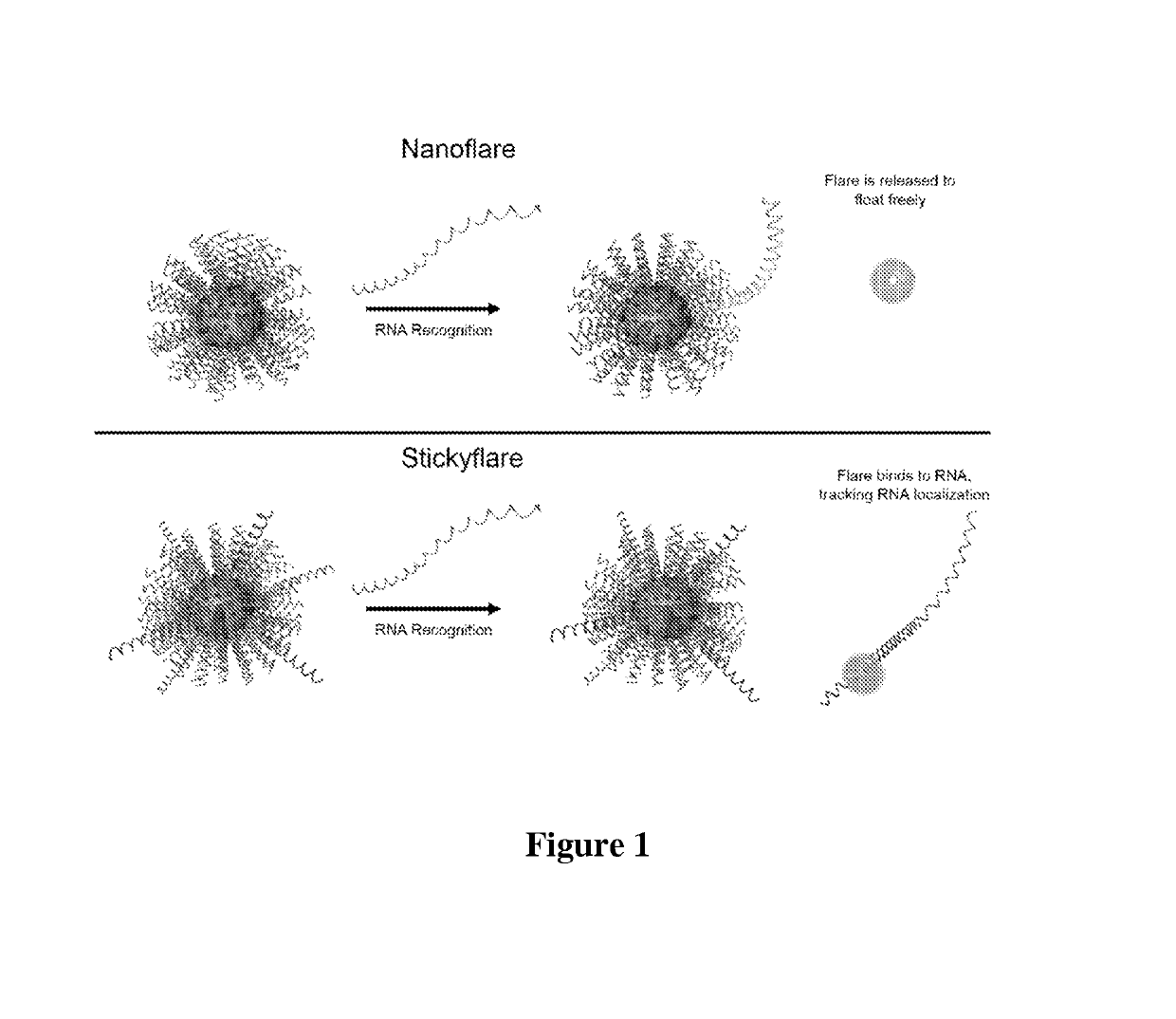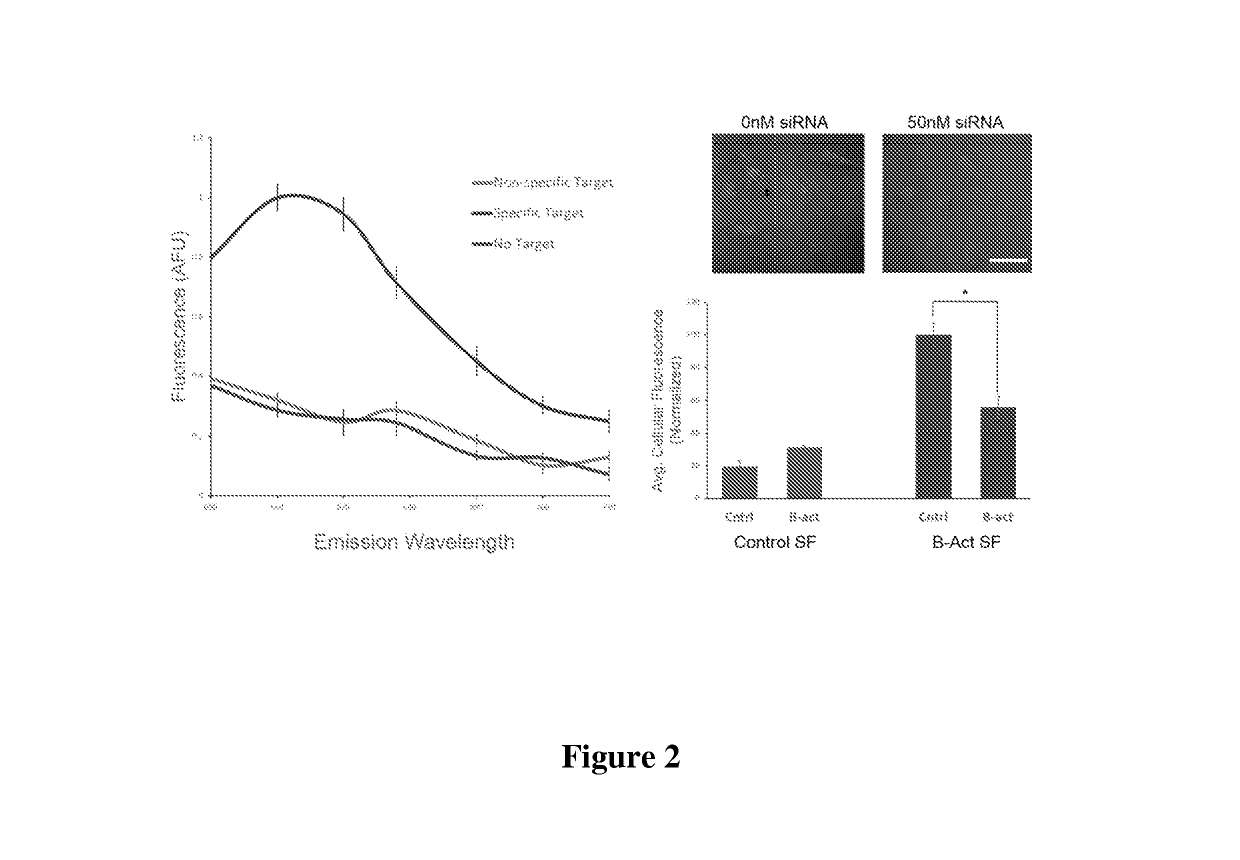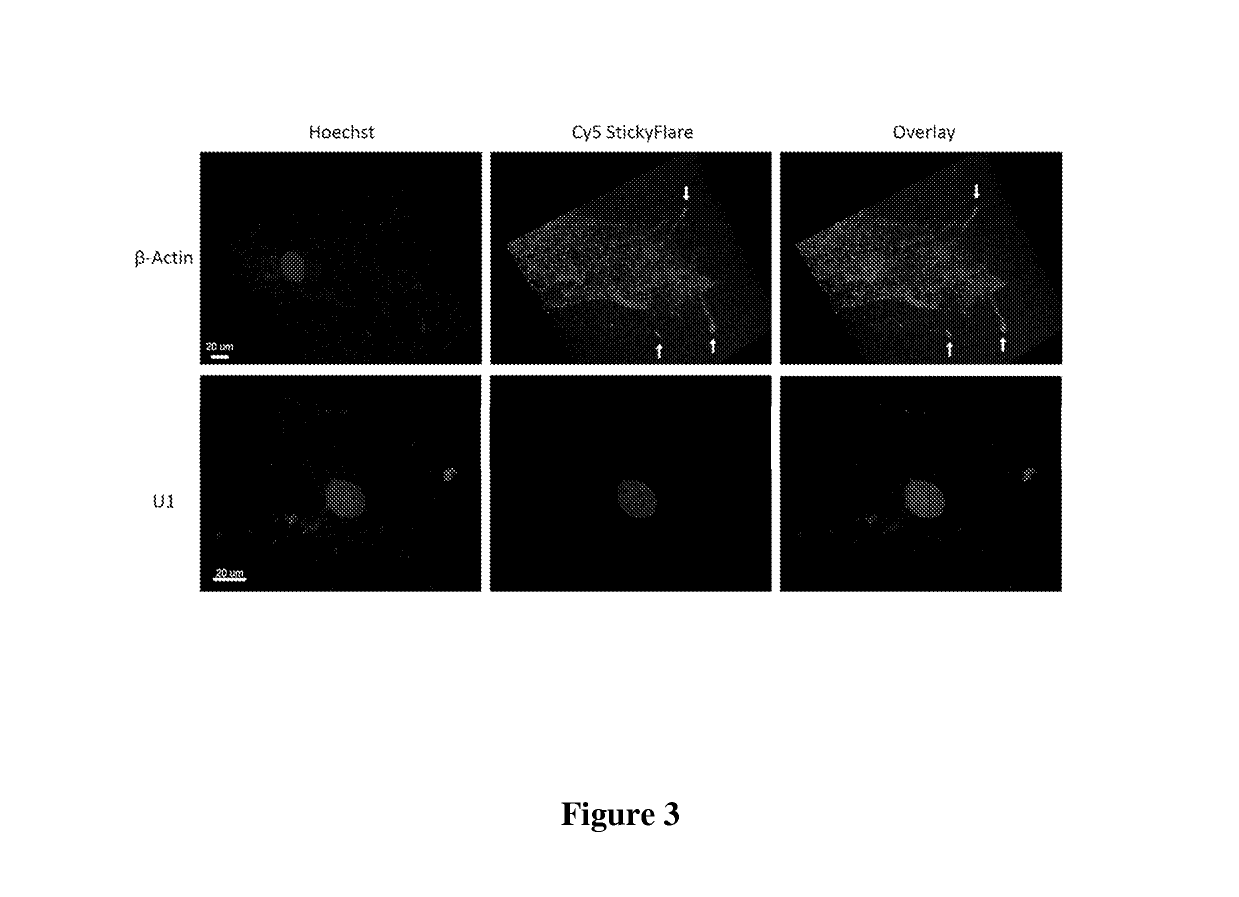Quantification and spatio-temporal tracking of a target using a spherical nucleic acid (SNA)
a technology of spherical nucleic acids and target molecules, applied in the field of detecting and tracking a target molecule using a nanoparticle, can solve the problems of limited visualization methods, inability to measure intracellular concentration and observe localization of mrna in live cells, and limited methods available to visualize these phenomena
- Summary
- Abstract
- Description
- Claims
- Application Information
AI Technical Summary
Benefits of technology
Problems solved by technology
Method used
Image
Examples
example 1
Design of the SNAs of the Disclosure
[0112]The design of the Nanoflare necessarily does not allow for investigation of the spatial distribution of targeted RNA. Release of the flare through Nanoflare-transcript binding results in a displacement of the fluorophore from the nanoparticle construct, and thus the transcript, as the RNA remains bound to the antisense capture sequences of the Nanoflare. However, were the complementarity of the Nanoflare oligonucleotides reversed, the result would be a Nanoflare-like construct with the important difference that the flare strands themselves are complementary to, and potentially capable of binding RNA targets. Such a construct may be engineered to perform similarly to the Nanoflare, using base-pair recognition of a target to displace fluorescent flare strands quantifiably, with the additional benefit that the complementary flare remains bound to the RNA (FIG. 1). Herein we report the development of such a construct, termed the Stickyflare, and...
example 2
Stickyflare Synthesis
[0113]Oligonucleotides were synthesized using standard solid-phase phosphoramidite chemistry (Expedite 8909 Nucleotide Synthesis System (ABI)). All reagents were purchased from Glen Research. Oligonucleotides were purified by reverse-phase high performance liquid chromatography (HPLC). The oligonucleotide sequences used in this study are shown below.
[0114]
SEQIDDescriptionSequence (5′→3′)NONon-TargetingCGT CTA CCT TCG CGC AAA AAA1A-Alkane ThiolNon-TargetingCy5- GCG CGA AGG TAG GCG GAG2FlareTCG GTC GAβ-ActinCCG GCA TGT GCA A AAA AAA A-3Alkane Thiolβ-Actin FlareCy5- TTG CAC ATG CCG GAG CCG4TTG TCG ACG Aβ-Actin TargetTCGTCGACAACGGCTCCGGCATGTGCAA5
[0115]To make the DNA-functionalized SNA conjugates, alkylthiol-terminated actin and survivin oligonucleotides (3 μM each) were combined with citrate-capped 13 nm gold particles (13 nM) and incubated for 1 hour at room temperature. Next, phosphate buffer (pH=7.4), and sodium chloride were added to a final concentration of 5 ...
example 3
Additional Stickyflare Studies
[0124]Stickyflare Synthesis was as described in Example 2. Briefly, oligonucleotides were synthesized using standard solid-phase phosphoramidite chemistry (Expedite 8909 Nucleotide Synthesis System (ABI)). All reagents were purchased from Glen Research, and the oligonucleotides were purified by reverse-phase high performance liquid chromatography (HPLC). The oligonucleotide sequences used in this study are shown below.
[0125]
SEQIDDescriptionSequence (5′→3′)NONon-CGT CTA CCT TCG CGC AAA AAA 6TargetingA-Alkane ThiolThiolNon-Cy5- GCG CGA AGG TAG GCG GAG 7TargetingTCG GTC GAFlareSurvivinGCA GCC CTT TCT CAA G AAA AAA 8ThiolA-Alkane ThiolSurvivinCy5- CTT GAG AAA GGG CTG CCA 9FlareGGC AGG GGSurvivinCCC CTG CCT GGC AGC CCT TTC10TargetTCA AGKRAS ThiolGCC CTG TGT GAA CCT AAA AAA 11A-Alkane ThiolKRAS FlareCy5- AGG TTC ACA CAG GGC CTG 12GCC TTG C KRAS TargetG CAA GGC CAG GCC CTG TGT GAA13CCTβ-Actin ThiolCCG GCA TGT GCA A AAA AAA A-14Alkane Thiolβ-Actin FlareCy5- TT...
PUM
| Property | Measurement | Unit |
|---|---|---|
| Tm | aaaaa | aaaaa |
| Tm | aaaaa | aaaaa |
| Tm | aaaaa | aaaaa |
Abstract
Description
Claims
Application Information
 Login to View More
Login to View More - R&D
- Intellectual Property
- Life Sciences
- Materials
- Tech Scout
- Unparalleled Data Quality
- Higher Quality Content
- 60% Fewer Hallucinations
Browse by: Latest US Patents, China's latest patents, Technical Efficacy Thesaurus, Application Domain, Technology Topic, Popular Technical Reports.
© 2025 PatSnap. All rights reserved.Legal|Privacy policy|Modern Slavery Act Transparency Statement|Sitemap|About US| Contact US: help@patsnap.com



